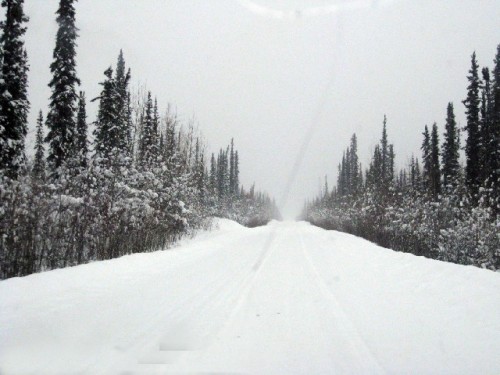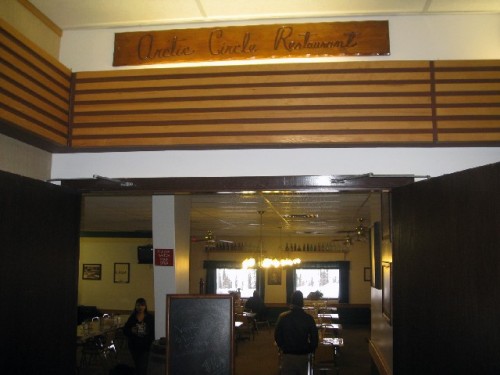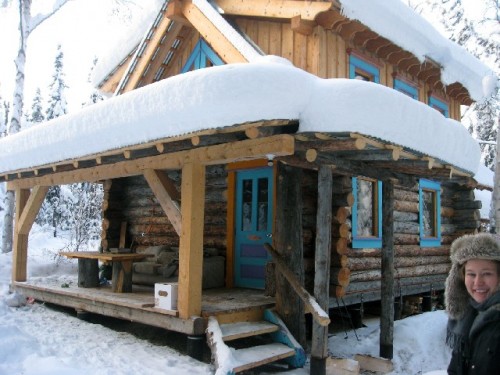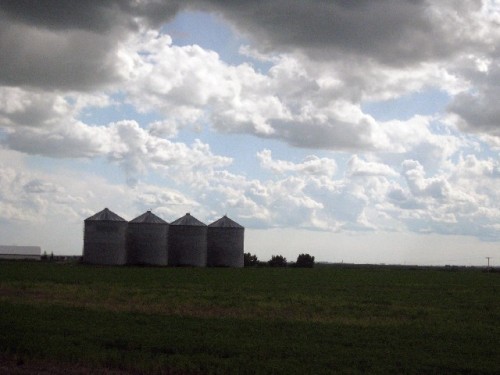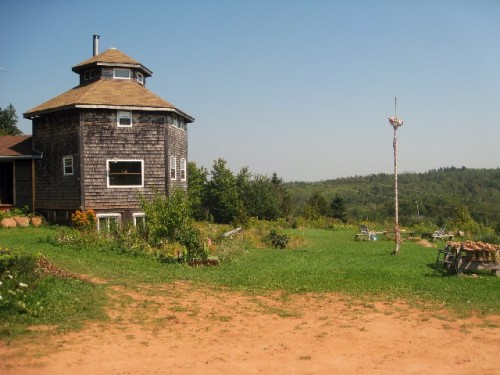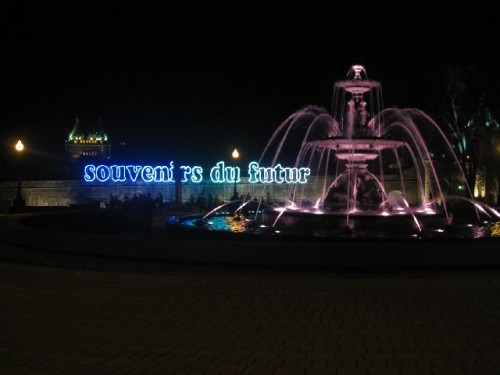Denise Markonish Part Three
Curating a Survey of Canadian Art for Mass MoCA
By: Denise Markonish and Charles Giuliano - Dec 16, 2011
Charles Giuliano Let’s discuss the 49th parallel and our frozen neighbors to the North. This Spring was one of triumph for our side of the border as the Boston Bruins defeated the Vancouver Canucks to win the Stanley Cup for the first time in 39 years. Other than ice hockey the majority of Americans are not very tuned in to the cultural richness and diversity of Canada.
My first visit to Montreal occurred some years ago when I represented Art New England on a junket organized for journalists. I extended my visit which gave me time to see the museums and galleries which were not included on the press itinerary. After the Museum of Fine Arts, and some tourist galleries along Sherbrooke Street, I felt discouraged. Over lunch I read the Mail Gazette, the English language paper. There was a story about Rene Blouin and his gallery on Saint Catherine Street (recently relocated to William Street).
When I arrived it was exactly what I have been looking for. I asked Rene if there were other such galleries? He said, of course. Then I asked why they were not listed in the official Gallery Guide. “You have to ask questions when you visit a city,” he said. It was the first of many lessons from Rene who has been a great friend for many years.
He wrote down the names and addresses of a number of the government sponsored Parallel galleries or artist run spaces. Most were then located along Saint Laurent which is known for its wonderful restaurants and Jewish neighborhood. That afternoon I frantically sought out the galleries. And, of course, had a smoked meat sandwich at Schwarz’s, the best deli in North America.
That summer I asked the tourism bureau to assist with a more extended visit. I drove up with my mother and Rene was delighted to meet her. Mom was very curious about a photo of a young woman wearing Jana Sterbak’s “Meat Dress.” I find it annoying that there is such a fuss being made over Lady Gaga’s “Meat Dress.” Jana did that so long ago. Rene represented her at that time. I spent a day at the MFA when Cathy Halbreich was the curator of contemporary art. With Jana they were assembling one of her meat dresses.
I returned to Montreal quite often for special exhibitions. And drove to Ottowa to write on the National Gallery designed by Moshe Safdie for Art News. His Olympics construction for the Olympics, call Habitat, is amazing. Early on the Museum of Contemporary Art was located outside the city and got very little traffic. It has since moved to Saint Catherine Street and seems more vibrant. Also I visited Ottowa for the first Canadian Biennnial. On another excursion, Astrid and I drove to Niagara Falls then on to Toronto, Ottowa, Montreal and home. We have also twice driven to Nova Scotia. On several occasions I traveled to Quebec City on art related projects. We stayed in the famous fortress hotel, The Frontenac.
So we are aware of the richness of Canadian culture, particularly the French influences of Montreal. As you note it is quite reachable from North Adams. We should try to visit more often; particularly as there are so many festivals. This summer is the Montreal Bienalle organized by the brilliant curator, Claude Gosselin. I have covered a number of his projects.
How did you decide to do a Canadian based project? What was the pitch to Mass MoCA? How was it funded as you were on the road for a considerable amount of time? How did you compile leads on what artists to seek out? As I understand it you made more than 400 studio visits across Canada. To what extent did that entail First Nation artists? What were the criteria by which you have reduced that critical mass of material down to the sixty plus who will be presented at Mass MoCA next summer? Has there been any effort to archive your search and make it available to scholars, critics and other curators? Will there be an on line data bank?
This will be the third such national survey for MoCA. The earlier one was Laura Heon’s overview of Austrian art with a focus on Vienna. Susan Cross and Joe Thompson have visited China and presented that work. Will there be other such surveys down the line?
Denise Markonish Yes I was glued to the TV with the Stanley Cup, unsure of which side I should be rooting for but glad in the end that the games were well matched. Though I must admit I was rather surprised by the rioting. Had Bostonians done it I wouldn’t have blinked an eye (thinking back now to when the Red Sox won the World Series in 2004), but to see Vancouverits acting that way...well it seemed so unCanadian! And I must say that you made my mouth water a bit there with the thought of a smoked meat sandwich from Schwartz’s - agreeably the best deli in North America- and oh the Montreal bagels....but I digress.
Why Canada? It’s the first question I inevitably get whenever I tell people about my project (well that and, “Are you Canadian?”). My first answer is always: Why Not! But to go back a little it started with an inner curiosity. I began to notice that a number of artists I responded to happened to be Canadian but wondered why it seemed that only a small group had filtered through in a more “international” way. This puzzled me, to know next to nothing about one of our closest neighbors. The art world is one that is often looking for the “next thing” and it does so, in my mind, in an almost colonialist manner – seeking out artists in India and China, effectively hoping to “rediscover” the so-called third world or the exotic. So I decided to go the opposite route and to look just due North. This was not a mission of just finding artists but rather of understanding the complex relationship between the US and Canada. We are thought to be so alike yet we don’t much consider the very real differences. The idea for the project was one I started thinking about just over four years ago and I remember mentioning when I interviewed for my job here at MASS MoCA (I also remember my initial answer to Joe Thompson’s ask of “Why Canada?” which was “Because it would be funny”).
I began doing research immediately, and the first thing I wanted to find out was if this had been done or not. It’s funny that you mention the Biennial at the National Gallery in Ottawa. Well that was the last cross Canada biennial to be organized and it was curated by Diana Niemeroff in 1990. Sure there have been regional shows like Nothings is Lost, Nothing is created, Everything is transformed: The Quebec Triennial; Flatlanders: Saskatchewan Artists on the Horizon; Scratching the Surface: The Post Prairie Landscape; Intertidal: Vancouver Art and Artists; Baja to Vancouver: The West Coast and Contemporary Art; the most recent Beyond Western New York, It Is What It Is (billed as a biennial but really a collection show at the National Gallery); and the Montreal Biennial you mentioned (though this year it was curated not by Claude but by Toronto curator David Liss and sadly it has already closed). So the only way I thought I could do such an exhibition (without it feeling like mere “discovery” or without reiterating the work already done) was to go, see as much as possible, meet with as many members of the creative sector as I could – call it an old fashioned grand tour of sorts.
This lack of attention to Canada also became even more apparent as between trips to visit artists I would do ongoing research in the office on the history of Canadian art. And just as we seemingly know little about contemporary Canadian art, the same is true for its history. One of the things that surprised me the most is what gets left out of art history taught in America. It is a history that nearly erases the Canadians. I am thinking here of how much I knew about the Hudson River School in comparison with the Group of Seven; the European surrealists but not the Montreal based Les Automatistes; the American abstract expressionists but not the Regina Five (despite the fact that Clement Greenberg actually wrote about painting in the prairies); or most troubling, the history of conceptual art at the Nova Scotia College of Art and Design (NSCAD). The importance of NSCAD in the development of conceptualism is very real and in school I remember reading about how Dan Graham and Sol LeWitt made work there, how John Baldessari did the print I Will Not Make Any More Boring Art there in 1971. But again, this is the history of Americans in Canada, one that leaves out the important work and influence of Canadians like Garry Neill Kennedy, Gerry Ferguson, David Askevold and Michael Fernandes.
So with all this in mind, I spent the last 3 years criss -crossing Canada (at this point I have been everywhere except for Nunavut, Labrador and the Northwest Territories, though I hope to remedy those omissions). I started by compiling vast lists, drawn from names given to me by curators, scholars, gallerists and mostly other artists. I think this initial list ran somewhere around 800 names or so. I looked at everyone and picked about 400 to visit in person (or sometimes over skype) – this included First Nations artists as well as French Canadians – both Acadians and Quebecois, and Inuit whom I visited this fall). From that came the most difficult task I have ever given myself as a curator – turn this mass of research into an exhibition. I wanted to create a show that would hold together rather than just being full of disparate work. So I had certain broad themes in mind, and wanted to curate a show that would be new not just for American audiences but for the Canadians as well. In the end I chose 62 artists, ranging from known to emerging, I could have been 5 or 6 different shows (and has been in my head or on my office walls at one point or another), and I had to say no to many artists making work I really like – so something tells me that you will see many more Canadians in my exhibitions for now on! And as for all the research, I am thinking of ways to make that public, it needs a bit more organization at the moment but lots of folks are asking for “the list.”
I could go on writing about this project much longer but perhaps that answers the first round of questions about Canada...
CG You raise several intriguing points such as the notion of Post Colonialism that motivates curators to visit and organize exhibitions from exotic destinations including Africa, China, and India. Curators are always trudging about terra incognita hoping to make great discoveries.
Compared to which the art world makes little effort to explore Canadian art and culture. The assumption is that there is nothing “exotic” to discover. Aren’t they just like us? But with harsher winters. Those who do make the effort know that there are very different cultural environments in Canada. Particularly the French speaking arts and culture of Montreal which are very different from Ottowa, a government based city, perhaps more like D.C., and Toronto which has a thriving culture with great theatre. Then there is the whole First Nation resource which is more prominent and widely supported than what exists in the U.S. primarily in the South West. There are indigenous communities all over our nation. For Suffolk University I organized a one person show by Jaune Quick-to-See Smith. She made a series of works on paper for the project. I also curated a provocative show “Native New Yorkers.” But it got little or no critical response in Boston.
Your project is taking a great leap toward creating a sense of transparency regarding our Northern border. It is significant that a major museum like Mass MoCA is providing this level of depth and exposure.
It is not surprising that colleagues are asking to take a peek at your list that started with some 800 names of artists. Too often curators are very lazy. They attend each other’s biennials and cherry pick for their own shows. You are admirable for providing such ambitious leg work. Where you have explored surely others will follow.
Particularly since Canada is so accessible. You can drive there. Which is not like taking a two week trip to China or India. It is so interesting that you have had many visits over the past year and have really driven deeply into the research. Not just the studio visits but the library and archival research as well.
You are absolutely right that Canadian art has been ignored and deleted from the standard accounts of North American modernism. Enormous efforts need to be undertaken to level the cultural playing field.
Canada and its government departments have made efforts to attract the American media. Particularly for its major festivals. But that funding eroded with the bad economy.
Did you get any Canadian support for your research? That’s a lot of travel, hotels and meals. I don’t think that Mass MoCA has the kind of deep pockets to keep a curator in the field for a year or more.
Can you share more of the anecdotes of your research? Where did you go, major cities as well as rural destinations? What were the joys and disappointments of that kind of field work? What kind of work enlightened and motivated you? Did you find anything different than visiting artists in the USA? Of course more funding is available to Canadian artists and surely that is an incentive to remain home. But there are also funds, as we learned by attending the Transcultural Exchange Conference in Boston, last April, to send Canadian artists for extended residences abroad.
How has this project changed you?
DM You are right to point out that Canada and the US are in fact very different places. I would say this wasn’t evident to me either until I started this project, but now I see the uniqueness of each place. Lots of people ask me if there is such a big difference between Canadian art and art produced in the US or even internationally. I always answer this by saying, it’s not about the work that gets made – that is right in line with international art making – but rather how it gets made. What I mean by this really stems from the funding systems for art in Canada, where there is strong governmental support (though sadly with ongoing conservative politics this is dwindling). In Canada unlike here, the idea of Artist – with a capital A – is respected as a career choice, rather than being seen as merely a pass time, therefore artists are given the room to be in the studio producing. Also, there is not a particularly strong commercial system in Canada (sure there are great galleries, particularly in the major cities but compared to say New York, they are few and far between). This leads to a more project based practice, a freedom to explore in the studio rather than produce “work for sale.”
You also brought up the First Nations artists, and that to me was one of the biggest surprises in my research. Here in the states, Native artists are virtually invisible outside the realm of craft – with the exception of folks like James Luna, Jaune Quick-To-See Smith, Kay Walking Stick and Jimmy Durham (lives abroad). In Canada, the First Nations presence is very strong, and they are dealing with their history in incredibly provocative ways. I visited many artists across the country from Terrance Houle in Calgary to Rebecca Belmore and Brian Jungen in Vancouver, Kent Monkman in Toronto and many others both established and emerging. I even conducted a great studio visit with Faye Heavyshield on the Blood Reserve just outside of Lethbridge. This looking into identity is prevalent in the First Nations community but outside as well, artists like Mario Doucette looking at the history of the Acadians in Canada, or Douglas Coupland, whose Canada House is an homage to all things Canadian from Terry Fox to Hockey to foodstuffs. Or younger artists like Charles Stankievech who is living in the Yukon and working on an ongoing project about the DEW Line (Defense Early Warning – a Cold War system set up across the Canadian north to detect Russian invasion). This goes on and on and it’s something I find really interesting given Marshall McLuhan’s famous quote, “Canada is the only country in the world that knows how to live without an identity.”
Aside from this look at the problematics of history and identity there are other trends I noticed that seemed to be particularly Canadian. There is a real return to making in Canada (that just seems on the cusp here) and a return to craft in a conceptual way – from working with felt to ceramics and so on. There is still a great legacy of the conceptual. And of course there is that particularly wry sense of Canadian humor, so subtle that if you blink you might miss it.
In terms of the research, since it has been spread out over a long time (three years) it wasn’t a big crunch on our budget here – plus I have learned to be a very savvy traveler! We are working on funding now and have some initial money from the Canada Council (particularly for the large catalogue that will accompany the show). In terms of where I have been...well here is a brief roll call of places: Vancouver, Edmonton, Calgary, Lethbridge, Standoff, Saskatoon, Regina (and some small towns around both cities), Winnipeg, Toronto, Ottawa, Hamilton, Montreal, Quebec City, Moncton, Sackville, Fredricton, Saint John, Charlettown (and small towns all around PEI), Halifax, Prospect, Corner Brook, St Johns, Whitehorse and Dawson City. I think that does it. It was always an adventure – I got to drive around the whole of PEI, up through all of New Brunswick, I also drove to Ottawa, Toronto and Montreal. Everywhere else I flew and rented cars so I could be both inside the city but also explore places and studios outside the city limits. I have spent three Canadian Thanksgivings in the country, two Canada Days and July 4ths. I have been in studios, homes, basements and anywhere else you could expect – and I have of course eaten poutine, smoked meat, caribou, Saskatoon berries, cod tongues, nanaimo bars and butter tarts.
Not to single out any one area over another but I think one of my most memorable trips will likely have been the Yukon this past February. I went to Whitehorse which is about the size of North Adams, the government is there. Then to tiny Dawson City (about 1000 people) an old gold rush town. That place is like being back in time with old wooden buildings leaning every which way. I met with the former Mayor John Steins who is an artist (as is his father). Did you know that Martin Kippenberger had a public work in Dawson called Metro-Net – a subway station entrance that led to his imagined underground metro system connecting cities all over the world, the installed piece of course led to nowhere? It was deinstalled in 2009 so I didn’t get to see it, but the artist Zin Taylor did a great video about it called Put Your Eye in Your Mouth. One of my studio visits in Dawson was across the ice road in a log cabin (Eryn Foster) another was only accessible via snowmobile (Veronica Verekly) and another was a 15 hour drive down the Dempster Highway to the arctic circle with Charles Stankievech (the road was closed after about 20 minutes so we didn’t make it there!). It’s a magical place, and one, like many Canadian cities, I hope to get back to.
So to answer your question, yes this has changed me, how could it not. And my friends tease me over the fact that I seem to be turning Canadian!
You mention in your question that others will likely follow suit, well that has been my hope all along...not to be some kind of trend setter but rather to open people’s eyes. I have always said that my goal for this project is to create a dialogue and if this gets people talking, like the show or not, then I have succeeded.



